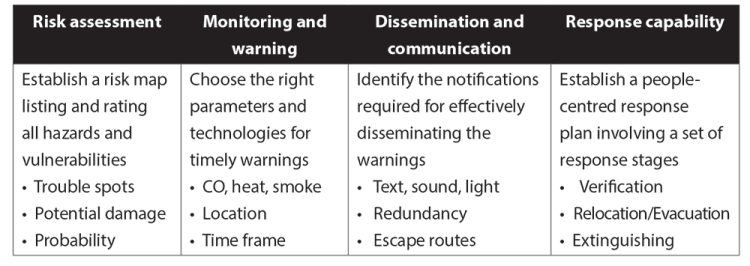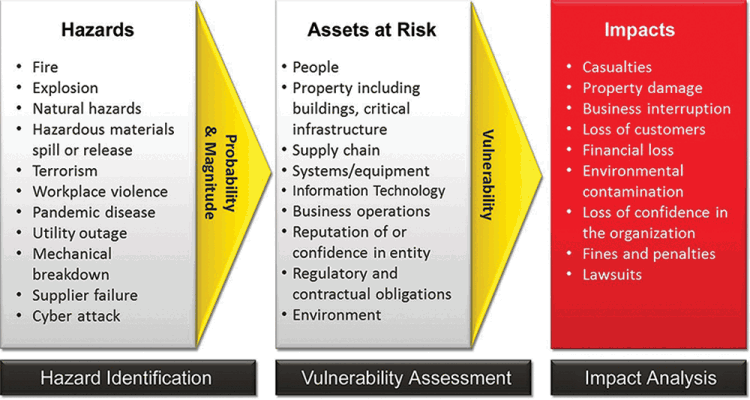
Early warning in case of smoke or fire is a major element of disaster risk reduction. It prevents loss of life and reduces the economic and material impact of disasters. To be effective, early warning systems need to actively involve the individuals at risk, facilitate staff education and awareness of risks, effectively disseminate messages and warnings and ensure there is a constant state of preparedness.
This article aims to present the basic elements, actions and good practices associated with effective early warning systems. It supports the development and implementation of early warning fire detection systems that are people-centred and whose warnings are timely and understandable to those at risk, including guidance on how to act upon warnings.

There are three key aspects to early warning fire detection systems, which are explained below.
Key actors
Developing and implementing an effective early warning system requires the contribution of a diverse range of individuals, organisational units and groups with different functions and responsibilities.
Management: The risk of a company having to close permanently after a fire disaster makes business continuity planning critical. This includes drafting a prevention plan, preparing for an impact, calculating the incident response time and looking into how the company can restore operations following a disruption.
For a data centre, for example, it is important that the operational teams are aware of potential problems before the customers notice them. With effective monitoring based on early warnings, problems can be fixed before they escalate. Knowing about potential threats and being able to detect and act upon them in a timely manner will substantially reduce the financial risks involved. Timely deliveries, prompt customer support and uninterrupted data processing are the merits of an early warning system.
Organisations need continuous access to their network and computer infrastructure and even a brief interruption to critical business processes can have devastating effects on revenue streams and customer confidence.
Therefore, for many businesses, best possible fire protection is imperative. Many of these businesses are even interdependent: Today’s economies are heavily driven by information technology controlling resource planning, production, order processing, transaction and logistics across continents and at high speed.
Academic community: Consultants, specifiers and engineers have a critical role in providing specialised technical input to assist in developing early warning systems. Their expertise is central to analysing risks, supporting the design of monitoring and warning services, supporting data exchange and to the dissemination of understandable warnings to those at risk.
Authorities having jurisdiction (AHJ): The AHJ play a crucial role in ensuring fire/life safety in buildings. It is essential that owners and fire officers of a building understand the role of the AHJ.
The AHJ are usually involved in the plan review process. This helps ensure that the building and its related systems meet the requirements of the adopted code. In other words: The AHJ are checking those parts of the building which need to be ‘code compliant’.
Early warning systems often:
• Deliver protection beyond code compliance (performance-based design vs prescriptive design).
• Deliver code compliance plus a set of performance enhancements.
It is therefore important to understand the code requirements and to seek an understanding with the AHJ regarding the code coverage of an early warning system.
The key elements
The objective of early warning systems is to empower individuals threatened by hazards to act in sufficient time and in an appropriate manner to reduce the possibility of personal injury, loss of life and damage to property and the environment.
A complete early warning system comprises four interrelated elements, spanning knowledge of hazards and vulnerabilities to preparedness and capacity to respond. Best practice early warning has strong interlinkages and effective communication channels between all of the elements.

Risk assessment: Fire risks arise from the combination of hazards and vulnerabilities at a particular location. While a data centre’s vulnerability may lay in the potential corrosion of circuit boards due to the contamination with combustion by-products generated by overheated wires, a power plant’s dominant risk might be the vulnerability of transmission elements such as switch gears and transformers. Whatever the application might be, it is important to analyse, identify and properly assess all hazards and vulnerabilities of a site. Risk assessments and maps are the base to prioritise. Early warning systems guide preparation for disaster prevention, proper incident detection and response.

Monitoring and warning: Warning services lie at the core of the system. Continuous monitoring of hazard parameters such as smoke, heat or gases at an elevated level of sensitivity is essential to generate accurate and timely warnings. Detectors for different hazards are to be coordinated by suitable processing of the information by the fire alarm control panel.
A properly designed fire detection and notification system is an essential part of an early warning fire alarm system. Aspects to consider when evaluating detection options include:
• Early initiation and response.
• Multiple warning levels.
• Interface to other systems.
o Suppression.
o Ventilation controls.
o Warning message dissemination.
o Building/incident management.
There are numerous detection approaches available to provide early warning of a fire. The inherent criticality and essential nature of a particular industry will often dictate the detection approach. Detection strategies typically include spot-type smoke, heat or gas detectors, air-aspirating detectors, linear heat detectors or a combination thereof. A proper risk assessment with clearly defined stakeholder goals help to guide the detection design. For example:
• Multi-criteria detectors (smoke/heat/carbon monoxide) are often an inexpensive and simple solution. However, they may be ineffective in case of:
o A fire in its incipient stage due to the comparably low sensitivity,
o Smoke is diluted due to high airflow, or
o Detectors are inaccessible to maintenance personnel for periodical testing due to restricted access.
Aspirating smoke detectors, or air-aspiration technology is becoming increasingly popular in mission critical applications. It is known for its ability to:
• Detect a fire in its incipient stage.
• Provide multiple warning levels supporting progressive response scenarios.
• Overcome airflow issues by actively drawing air in for subsequent analysis.
• Overcome smoke dilution issues by sensing at extremely high sensitivity.
• Overcome access issues by providing easily accessible test points.
The first two abilities are of importance for early warning systems. High sensitivity usually translates into earlier detection while multiple warning levels may deliver the triggers for responding in an adequate manner.
Dissemination and communication: Warnings must reach those at risk as well as those on duty to respond. Clear messages containing simple, useful information are critical to enable proper response. The necessity for multiple communication channels needs to be assessed to avoid failure of any one channel and to reinforce the message.
Response capability: Early warning fire detection systems offer warnings at different sensitivity levels of detection. Each of the so-called pre-alarms is calling for a specific set of actions. Typically, the very first of this set of early warnings is requesting the fire officer on duty to verify the indicated condition and if confirmed, to try to locate, isolate and eliminate the source of trouble. Only at a higher stage of warning will he be asked to take precautionary measures such as issuing the fire alarm to the building, evacuating the scene, calling the emergency team or initiating extinguishing.
It is essential that responsible individuals understand the risk, respect the warning and know how to react. Training and preparedness play a key role. Disaster management plans need to be in place, well-practiced and tested. The individuals at risk should be well informed about options for safe behaviour, available evacuation routes and how to best avoid damage and loss of property.
The challenges in disaster management are characterised by incomplete pictures of the current situation, ad-hoc decision taking and general unpredictability. Disaster management software deals with supporting staff in emergency situations by providing relevant information, facilitating task and resource allocation and managing communication with all involved parties. Properly implemented and exercised, it helps to handle the typical information overload and taking sound decisions in a stressful situation.
Purpose and use
The matrix shown in Table 1 offers a perfect framework to lay the foundations for any early warning fire detection project when reloaded with the definitions found in the relevant codes. Let’s take a data centre as an example:
You may identify all risk statements given in NFPA 75, NFPA 76 and FM 5-32 and list them under the headline ‘Risk assessment’. Subsequently, you may do the same for the other categories ‘Monitoring and warning’, ‘Dissemination and communication’ and finally ‘Response’. Finally, you may fill in all other relevant information found in fire statistics.
The result is a crisp clear picture on all criteria to be addressed when deciding on the design approach (performance-based vs. prescriptive) or discussing with the AHJ, the engineering party or the data centre management.

© Technews Publishing (Pty) Ltd. | All Rights Reserved.